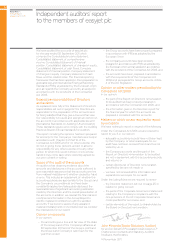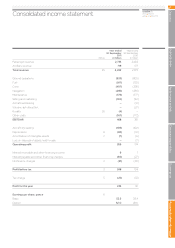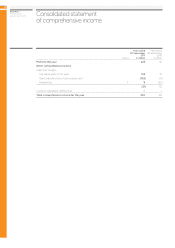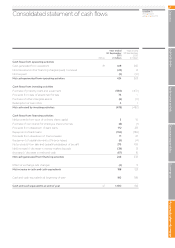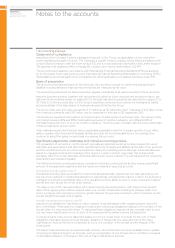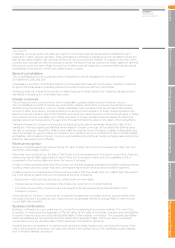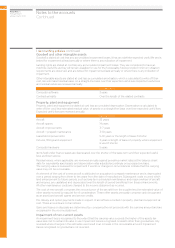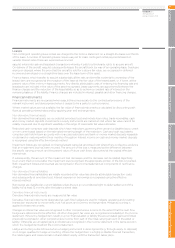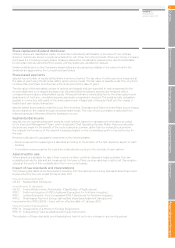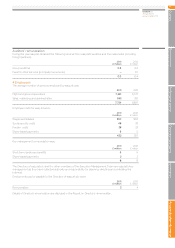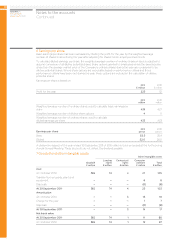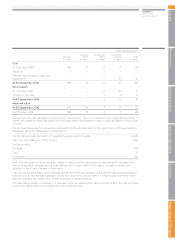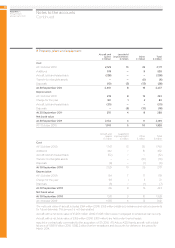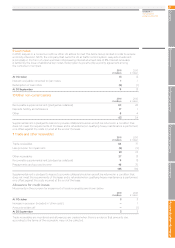EasyJet 2011 Annual Report Download - page 75
Download and view the complete annual report
Please find page 75 of the 2011 EasyJet annual report below. You can navigate through the pages in the report by either clicking on the pages listed below, or by using the keyword search tool below to find specific information within the annual report.
Leases
Non-contingent operating lease rentals are charged to the income statement on a straight-line basis over the life
of the lease. A number of operating leases require easyJet to make contingent rental payments based on
variable interest rates; these are expensed as incurred.
easyJet enters into sale and leaseback transactions whereby it sells to a third-party rights to acquire aircraft.
On delivery of the aircraft, easyJet subsequently leases the aircraft back, by way of an operating lease. Surpluses
arising on disposal, where the price that the aircraft is sold for is above fair value, are recognised in deferred
income and amortised on a straight-line basis over the lease term of the asset.
Finance leases, which transfer to easyJet substantially all the risks and benefits incidental to ownership of the
leased item, are recognised at the inception of the lease at the fair value of the leased asset, or, if lower, at the
present value of the minimum lease payments. Any directly attributable costs of entering into financing sale and
leasebacks are included in the value of the asset recognised. Lease payments are apportioned between the
finance charges and the reduction of the lease liability so as to achieve a constant rate of interest on the
remaining balance of the liability. Finance charges are included in interest payable and other financing charges.
Financial instruments
Financial instruments are recognised when easyJet becomes a party to the contractual provisions of the
relevant instrument and derecognised when it ceases to be a party to such provisions.
Where market values are not available, the fair value of financial instruments is calculated by discounting cash
flows at prevailing interest rates and by applying year end exchange rates.
Non-derivative financial assets
Non-derivative financial assets are recorded at amortised cost and include loan notes, trade receivables, cash
and money market deposits. Investments in equity instruments are carried at cost where fair value cannot be
reliably measured due to significant variability in the range of reasonable fair value estimates.
Restricted cash comprises cash deposits which have restrictions governing their use and is classified as a current
or non-current asset based on the estimated remaining length of the restriction. Cash and cash equivalents
comprise cash held in bank accounts with no access restrictions and bank or money market deposits repayable
on demand or maturing within three months of inception. Interest income on cash and money market deposits
is recognised using the effective interest method.
Impairment losses are recognised on financial assets carried at amortised cost where there is objective evidence
that an impairment loss has been incurred. The amount of the loss is measured as the difference between
the asset’s carrying amount and the present value of future cash flows, discounted at the original effective
interest rate.
If, subsequently, the amount of the impairment loss decreases, and the decrease can be related objectively
to an event that occurred after the impairment was recognised, the appropriate portion of the loss is reversed.
Both impairment losses and reversals are recognised in the income statement as components of net finance
charges.
Non-derivative financial liabilities
Non-derivative financial liabilities are initially recorded at fair value less directly attributable transaction costs,
and subsequently at amortised cost. Interest expense on borrowings is recognised using the effective
interest method.
Borrowings are classified as current liabilities unless there is an unconditional right to defer settlement of the
liability for at least 12 months after the balance sheet date.
Derivative financial instruments
Derivative financial instruments are measured at fair value.
Derivative financial instruments designated as cash flow hedges are used to mitigate operating and investing
transaction exposures to movements in jet fuel prices and currency exchange rates. Hedge accounting is
applied to these instruments.
Changes in intrinsic fair value are recognised in other comprehensive income to the extent that the cash flow
hedges are determined to be effective. All other changes in fair value are recognised immediately in the income
statement. Where the hedged item results in a non-financial asset or liability the accumulated gains and losses
previously recognised in other comprehensive income form part of the initial carrying amount of the asset or
liability. Otherwise accumulated gains and losses are recognised in the income statement in the same period in
which the hedged items affect the income statement.
Hedge accounting is discontinued when a hedging instrument is derecognised (e.g. through expiry or disposal),
or no longer qualifies for hedge accounting. Where the hedged item is a highly probable forecast transaction,
the related gains and losses remain in shareholders’ equity until the transaction takes place.
easyJet plc
Annual report
and accounts 2011
GovernanceCorporate responsibility
Business review Performance and risk
Overview Accounts & other information
73



